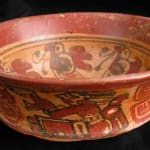Copador Style Mayan Polychrome Bowl, 300 CE - 900 CE
Terracotta
8.875 x 3.5
PF.5655
Further images
The most interesting feature of this bowl is its bottom. Fifteen indented lines radiate outwards from the flat center of the vessel like the petals of a flower. The curved...
The most interesting feature of this bowl is its bottom. Fifteen indented lines radiate outwards from the flat center of the vessel like the petals of a flower. The curved rim of the exterior is decorated by a series of three seated figures alternating with a frieze of six glyphs, divided into two rows of three. The figures, propped up against backrests, hold their hands forth as if making an offering. They all wear headdress and ear ornaments. A frieze of six stylized turkeys, a staple of the Mayan diet, marches around the interior of the bowl. Painted with red tails and necks, they in their beaks what appears to be a black worm. There must be some significance between the varied motifs. How do the seated man and the turkey relate to each other? Discovered in a tomb, buried alongside a fallen ruler or important dignitary, this bowl was as essential for the afterlife as it no doubt was in this world.





